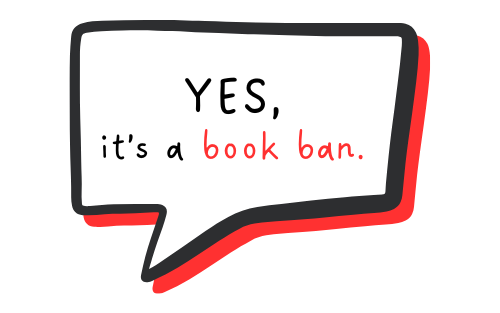Have you been told that a book isn’t “banned” if it is still available on Amazon or at the public library?
Removing or restricting access to a book meets the definition of a book ban.
Have you been led to believe that pornographic material is in your public school library?
There have been no documented instances of pornographic materials being found in a public school library.
Those who seek to violate your First Amendment rights by banning books resort to fear-mongering to gain public support for their actions.
Knowledge is power. Learn the facts about book banning here.
Got Questions? We Have Answers!
How can a book be “banned” if it is available for purchase at bookstores and at public libraries?
The Free Speech Center at Middle Tennessee State University defines book banning as a form of censorship where private citizens, government officials, or organizations remove books from libraries, school curriculum, or bookstores because they find the content, ideas, or themes objectionable.
Are books really being banned?
Yes. Anti-censorship organization PEN America counted 3,362 book bans in public school libraries and classrooms for the 2022-2023 academic year. The American Library Association’s Office of Intellectual Freedom found that challenges to books in public libraries accounted for 49% of all book challenges reported. In Virginia in 2022, a Republican state legislator attempted to make it illegal for bookstores to sell Gender Queer and A Court of Mist and Fury to minors without parental permission because he believed the books were obscene.
A number of states have passed legislation that has resulted in the sweeping removal of hundreds of book titles from school libraries, and have attempted to pass legislation that would have seized control of public libraries and put them under the control of local (partisan) officials, and/or removed funding sources.
I heard that pornographic books have been discovered in public school libraries. Isn’t it a good thing to keep porn away from kids?
Those who make these types of claims are ignoring the legal definition of obscenity and the Miller test.
The Miller Test has three prongs:
- (1) whether the average person applying contemporary community standards would find the work, taken as a whole, appeals to the prurient interest;
- (2) whether the work depicts or describes, in a patently offensive way, sexual conduct specifically defined by the applicable state law; and
- (3) whether the work, taken as a whole, lacks serious literary, artistic, political or scientific value.
To be obscene, the material must meet all three prongs.
Standards for what is considered harmful to minors can be different than the standards for adults. Even still, the books that some declare obscene do not meet this narrower definition. Harmful materials for minors include any communication consisting of nudity, sex or excretion that:
- (1) appeals to the prurient interest of minors;
- (2) is patently offensive to prevailing standards in the adult community with respect to what is suitable material for minors; and
- (3) and lacks serious literary, artistic, political, or scientific value for minors.
Book banners want to apply their definition of obscenity to books and materials within their public schools, other public schools, public libraries, across their state, and across the country. That is simply not how obscenity laws work.
What books are being removed from school libraries and classrooms?
There are literally thousands of unique titles that are banned or currently being challenged. It is impossible to capture all of them in one place. A good place to start is PEN America’s Index of School Book Bans. Some books banned and challenged in the 2022-2023 school year include:
- To Kill A Mockingbird
- The Giver
- And Tango Makes Three
- 1984
- Brave New World
- Fahrenheit 451
- I Know Why the Caged Bird Sings
- Fred Gets Dressed
- What Was Stonewall?
- The Complete Maus: A Survivor’s Tale
I just don’t think we should be talking about sexual orientation and gender identity in school. What’s wrong with letting parents decide if and when they want to teach their kids about homosexuality?
Look, LGBTQ people exist whether you like it or not. Your child probably knows someone who is LGBTQ. It’s important for children to see people like themselves and families like their own in the books they read because it fosters a sense of belonging. Children who do not identify as LGBTQ benefit from LGBTQ books because they help teach empathy and understanding. Kids are exposed to sexual orientation and gender identity from the day they are born, although most often what they are exposed to is a cisgender, heterosexual viewpoint.
It’s important to remember that as a parent, you do have control over what your kids can check out from the library. If you have concerns over what materials your child has access to in their school library, your school librarian would be happy to meet with you and develop a plan to restrict your child from checking out materials that concern you. Accommodations like this have always been available to parents.
A lack of LGBTQ representation in literature sends a subtle message that those identities aren’t valued, aren’t normal, and that their stories aren’t worth sharing. Additionally, LGBTQ teens state that they need supportive school environments, but only 26% feel safe in their classroom, and only 5% feel that their teachers and school staff are supportive of the LGBTQ community.
If you care about all children, you need to make sure all children are represented in your library.

